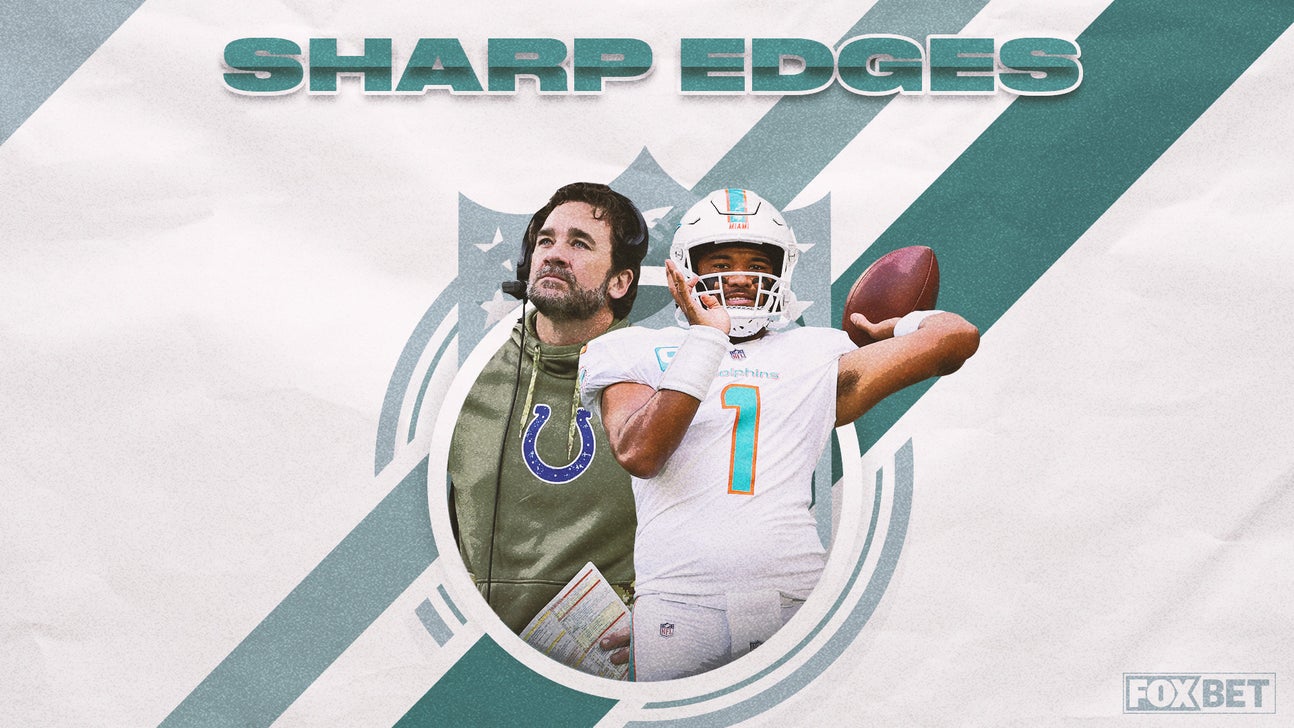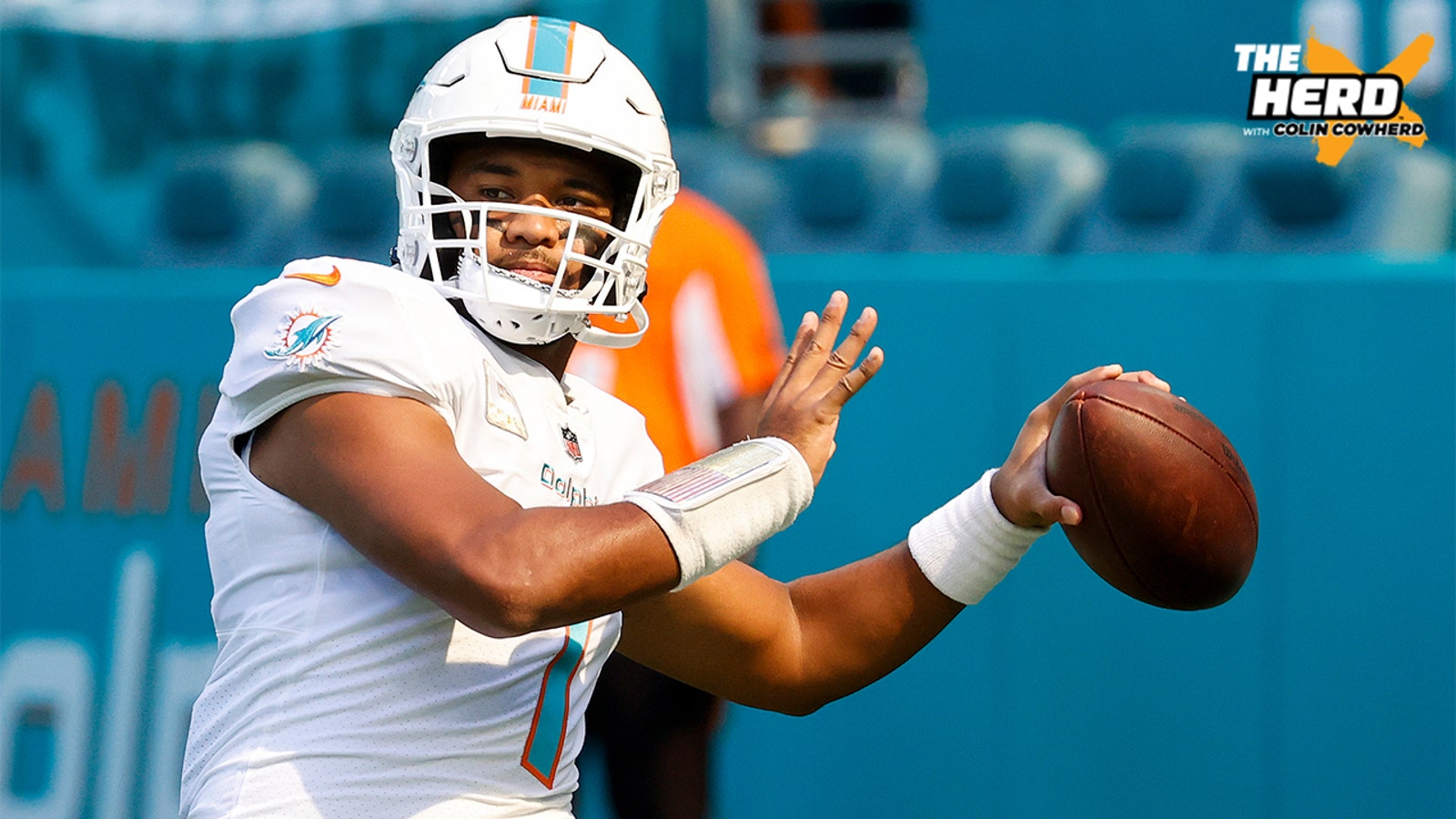
Tua Tagovailoa's historic red-zone success; Colts' blunder: Sharp Edges
When Tua Tagovailoa is in the red zone, he’s been absolutely money. On the season, 36% of the passes he throws there result in touchdowns.
That ranks No. 1 in the NFL this year. And is the best season for any QB since 2020 (minimum 30 attempts). His success rate (56.8%) is No. 1 and his expected points added per attempt (+0.42) ranks No. 2.
Tua's percentage of incompletions due to inaccuracy is fourth-lowest of 56 qualifying QBs over the last two years.
But if you strip away individual seasons and look at all QB stats accumulated since 2000, you’ll find that Tua currently ranks first in touchdown rate (31%). And among 112 QBs with at least 100 red-zone attempts since 2000, Tua’s career ranks:
- No. 1 in success rate (49%)
- No. 1 in touchdown rate (31%)
- No. 1 in third-down conversion rate (48%)
- No. 2 (second-lowest) in sack and interception rate (4.6%)
- No. 3 in completion rate (61%)
- No. 5 in first-down rate (36%)
- No. 11 in EPA per dropback (+0.17)
Getting down to the red zone is challenging. Making it count when you’re there is vital. Tua has been the best in the NFL (since at least 2000) at making his chances count when the Dolphins are down there. And that’s going to be vital against the 49ers on Sunday afternoon.
First and foremost, the 49ers have allowed just 22% of opponent drives to reach the red zone. That’s second-best in the NFL.
That’s in part because the 49ers have faced the third-easiest schedule of offenses this year. They’ve played some really terrible units. But they also have an outstanding defense, schedule aside. And in their last three games, they’ve held the Chargers, Cardinals and Saints offenses to a total of only five trips to the red zone and only one red-zone touchdown.
PFF has Tua Tagovailoa as its highest-graded QB this season
While that has been a big talking point among TV commentators, it deserves to be mentioned that in the prior three games, against the Falcons, Rams and Chiefs (only one of which is an elite offense) the 49ers surrendered 10 red-zone trips and nine red-zone touchdowns.
So yes, the 49ers have been elite defensively these last three weeks. But in the three games prior, they were anything but elite in the red zone. And now they’re facing the NFL’s most efficient quarterback in the red zone.
The problem for Tua is he’ll be without starting left tackle Terron Armstead. But I’m already looking forward to what happens in the red zone when Tua faces this 49ers defense on Sunday.
League-wide red-zone offensive efficiency at a 10-year low
While Tua has been great, red-zone offense has taken a big step back in 2022 compared to prior years.
The rate of red-zone drives which score points of any kind has fallen from 87.3% last year to 85.7% this year. We haven’t seen worse red-zone scoring since 2011.
Naturally, when teams go for it more often on fourth down in the red zone, we’re less likely to see scores of any kind, but should be more likely to see points. While fourth-down failures lead to zero points instead of the three derived from a field goal, fourth-down conversion could lead to seven points as opposed to three points from a FG.
But we’re seeing only 4.8 points scored per red-zone drive. We haven’t seen fewer points scored per red-zone drive since 2014. What is happening?
For starters, let’s discuss what is working.
Teams are having just as much success running the ball with running backs in the red zone as they ever did. Rushing EPA/play from running backs is +0.04 EPA/att. That’s identical to last year and hasn’t been topped since 2008.
Designed QB runs are averaging +0.30 EPA/att, which is slightly below 2021 (+0.31) but above both 2019 and 2020 and reasonably in line with historical averages.
QB scrambles are averaging +0.79 EPA/att, which are well above what we saw in 2021 (+0.62) and the best we’ve seen in the NFL since 2001, when far fewer QBs were scrambling.
However, QB pass attempts are delivering the worst efficiency that we’ve seen since at least 2000, which is as far back as TruMedia data goes.
QBs are averaging -0.03 EPA/dropback (without scrambles), worst since 2000. And if we remove sacks, spikes and throwaways and focus only on pass attempts, QBs in 2022 are averaging just +0.07 EPA/att.
Not only is that the worst in the NFL since at least 2000, it’s half of what QBs were delivering the prior five years:
- 2022: +0.07 EPA/att
- 2021: +0.15
- 2020: +0.14
- 2019: +0.17
- 2018: +0.16
A big part of the problem is what QBs are doing when they are NOT being blitzed. Look at the results this season when QBs are not being blitzed relative to the prior few years:
- 2022: +0.02
- 2021: +0.12
- 2020: +0.13
- 2019: +0.16
- 2018: +0.18
When QBs are not blitzed, they are still being pressured 25% of the time on red-zone dropbacks (highest since 2019) and are holding onto the ball for 2.63 seconds before passing (second-highest since 2000).
On the contrary, when QBs are being blitzed but not sacked, their EPA/dropback (+0.16) is down slightly from the last couple of years (+0.22 in 2021, +0.18 in 2020), but isn’t the big cause for concern, as it’s still better than what we saw in virtually every year from 2011-2018.
The biggest problem with red-zone efficiency in 2022 isn’t RB runs (the best they’ve been since 2008) and it isn’t QB scrambles (the best they’ve been since 2001). More teams need to lean into these types of plays in the red zone. The problem is QB dropback efficiency when the defense isn’t blitzing.
Teams need to study what works and what doesn’t, then formulate a better plan to call pass plays. Relying too heavily on red-zone passes could derail a team’s playoff hopes.
Coaching mistakes in Indianapolis
We just saw the Indianapolis Colts blow an opportunity to tie their game with the Steelers, while holding three timeouts in their pocket and taking two of them to the locker room having gone unused.
After the game, they claimed it wasn’t an issue with the clock, but a matter of execution.
The Colts have a playcaller who has never called plays in his life until a couple of weeks ago.
After they picked up a first down on a fourth-and-3 on their best play out of the two-minute warning, on a moving clock, they called:
- A first-and-10 pass play at the Steelers' 33 which resulted in a sack (at 1:35)
- A second-and-17 pass play at the Steelers' 40 which resulted in a QB scramble (at 0:59)
- A third-and-3 RB run play at the Steelers' 26 which resulted in no gain (at 0:34)
And then they called a timeout at 0:30.
What the Colts fail to account for is the stress that is on any playcaller in late-game situations. On a moving clock without substituting in personnel, they have a limited range of plays they are working with. That alone limits their ability to get in their best play.
But the play has to be relayed down to the QB within seconds in these situations. It’s unreasonable to expect Parks Frazier, a 31-year-old in his first year being more than a quality-control coach and an assistant QB coach, to ensure that he had the best play with the best personnel calls in this situation.
Jeff Saturday loses MNF for Colts with poor clock management
And that assumes the team does not legitimately run out of time — and we don’t know if they would have, because they didn’t make it past the Steelers' 26-yard line and only 24 seconds remained.
I’d venture to say they both would have run out of time and didn’t get their best plays into the game as a result of not using their timeouts properly.
Warren Sharp is an NFL analyst for FOX Sports. He is the founder of Sharp Football Analysis and has worked as a consultant for league franchises while also previously contributing to ESPN and The Ringer, among other outlets. He studied engineering before using his statistical acumen to create predictive football models. You can follow Warren on Twitter at @SharpFootball.












